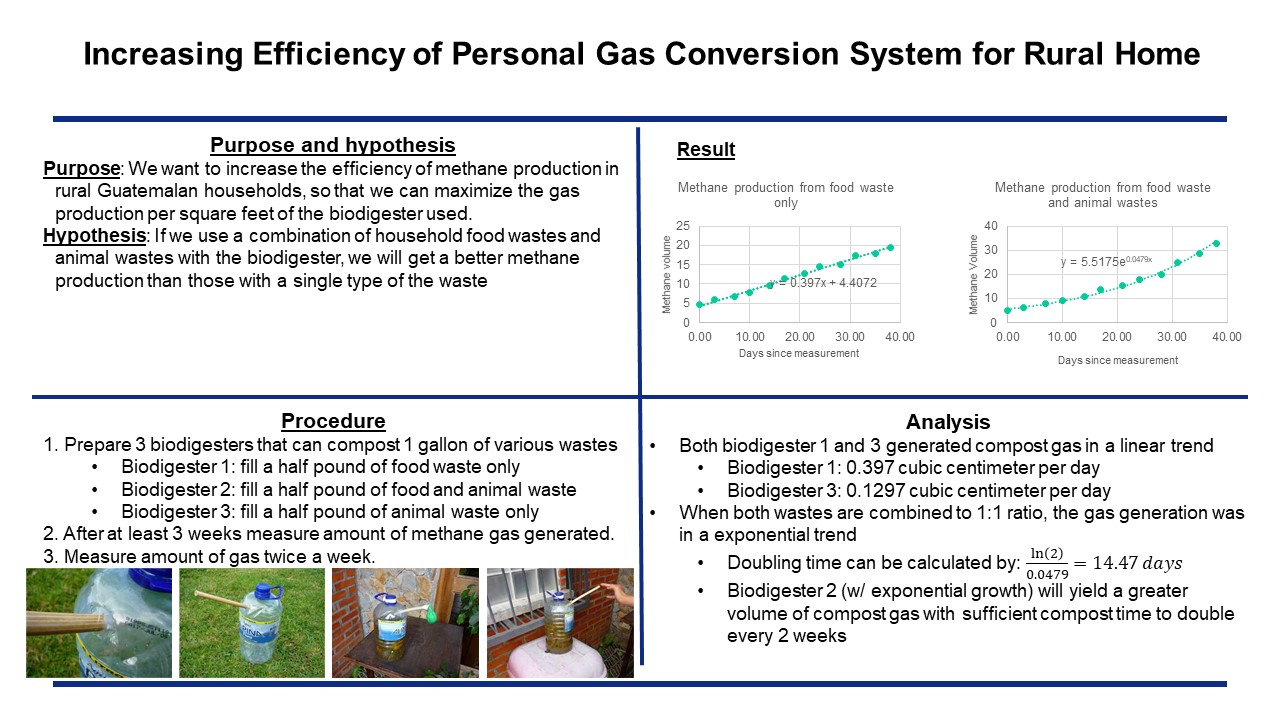Increasing Efficiency of Personal Gas Conversion System for Rural Homes
Abstract:
Bibliography/Citations:
1. Amon, T., Amon, B., Kryvoruchko, V., Zollitsch, W., Mayer, K., & Gruber, L. (2007). Biogas production from maize and dairy cattle manure—Influence of biomass composition on the methane yield. Agriculture, Ecosystems & Environment, 118(1-4), 173–182. doi: 10.1016/j.agee.2006.05.007
2. Bouallagui, H. (2003). Mesophilic biogas production from fruit and vegetable waste in a tubular digester. Bioresource Technology, 86(1), 85–89. doi: 10.1016/s0960-8524(02)00097-4
3. Themelis, N. J., & Ulloa, P. A. (2007). Methane generation in landfills. Renewable Energy, 32(7), 1243–1257. doi: 10.1016/j.renene.2006.04.020
4. Viswanath, P., Devi, S. S., & Nand, K. (1992). Anaerobic digestion of fruit and vegetable processing wastes for biogas production. Bioresource Technology, 40(1), 43–48. doi: 10.1016/0960-8524(92)90117-g
5. Weiland, P. (2009). Biogas production: current state and perspectives. Applied Microbiology and Biotechnology, 85(4), 849–860. doi: 10.1007/s00253-009-2246-7
Additional Project Information
Project files
Research Plan:
The plan is to 1) assemble a biodigester from easy-to-access materials (e.g. plastic bottles), 2) try out various conditions for biodigester, and 3) compare the result to find the best condition that will generate the most methane.
The biodigester will be made from a large (~1 gallon) plastic bottle with a hole punched on the top to release the gas from the compost. Prior to experiment, a half pound of various wastes will be placed inside the bottle. The hole will be connected to a balloon and sealed tightly to prevent aby leakage. The balloon will inflate as the gas is released from the compost, allowing us to measure the amount of gas generated from the waste. For the experiment, three digesters will be prepared and measured simultaneously.
Roughly a half pound of three different types of wastes will be placed in each digesters. Household waste (digester 1), a 1:1 ratio of household waste and animal waste (digester 2) and animal waste (digester3) will be digested. Other conditions such as temperature and humidity will be same for all digesters.
Lastly, circumference of the balloons will be measured after three weeks of the initial incubation. This will be the start date of the measurement. The balloons will be measured twice a week for total of 6 weeks. The final volume will be compared and the data points will be plotted and analyzed further.
Questions and Answers
1. What was the major objective of your project and what was your plan to achieve it?
Rural towns are rife with raw bio-materials that can be used for biogas generation, which would reduce dependency on the electrical grid. Because many rural villages have less reliable access to the grid, personal home generators can be a great alternative for energy use. Through food waste and animal waste, rural homes can conceivably be powered by biogas generators, which convert energy from those sources.
The main goal was to assess different waste combinations to analyze which most efficiently produces biogas. To figure out the best combination, I set up a series of experimental units with different mixtures of waste and tested the efficiency of each unit.
2. What were the major tasks you had to perform in order to complete your project?
I had to assemble and set up experimental units, measure biogas output daily, and analyze the data.
3. What is new or novel about your project?
Biodigesters are usually created for industrial scale and used by municipalities. My project is new in that it sought to leverage the technology for the personal scale, so that individual homes can use and be powered by it. Finding the most efficient combination for personal homes is necessary to assess the feasibility of a generator powering a home.
4. What was the most challenging part of completing your project?
The testing process was the most time consuming and challenging. Twice a week, I measured the different outputs, and sometimes had to adjust the measurements days into the experiment. Throughout the process, I learned that even if experimental units are small, they need to be sourced from high quality materials.
5. If you were going to do this project again, are there any things you would you do differently the next time?
I would try to find an experimental process that is more efficient and less time consuming.
6. Did working on this project give you any ideas for other projects?
While I worked towards gas generation for rural homes, I am curious how this project can translate to biogas generators for coastal towns and village homes, where algae is more abundant.
7. How did COVID-19 affect the completion of your project?
It didn’t.

